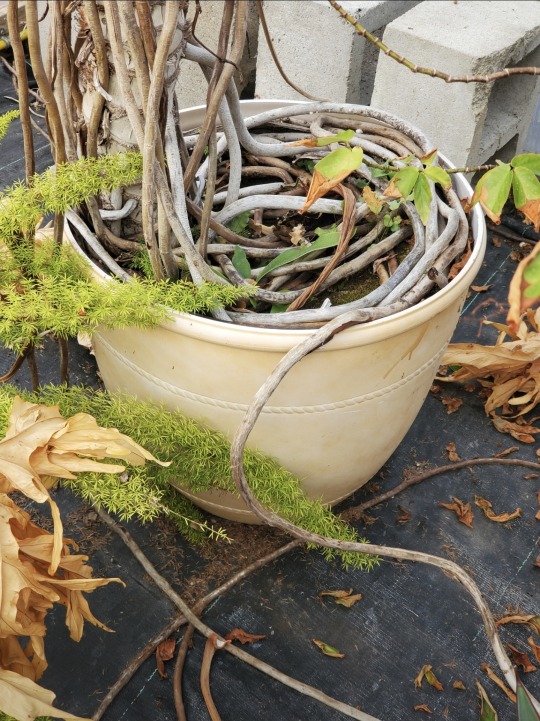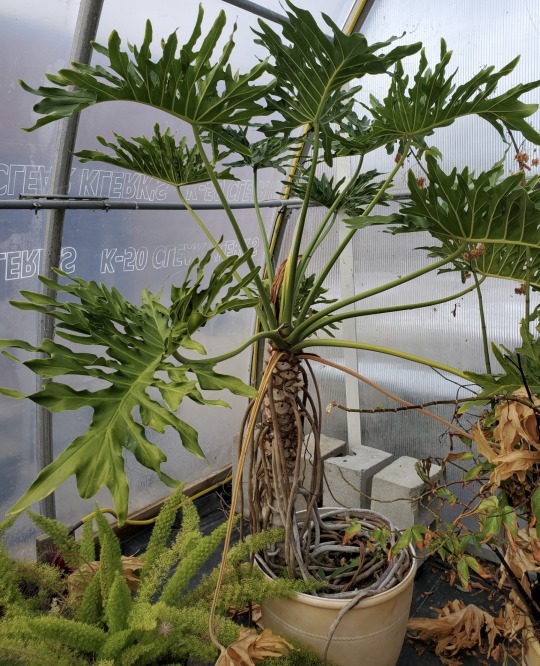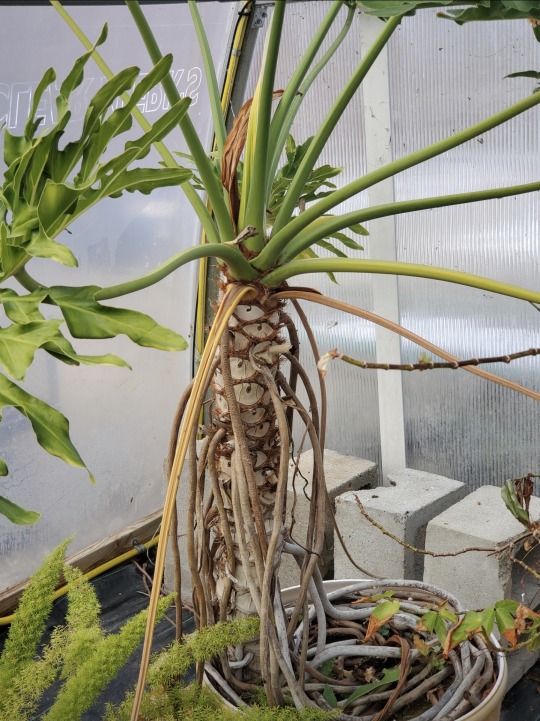#Thaumatophyllum bipinnatifidum
Explore tagged Tumblr posts
Text

#atrium#bougainvillea#architecture#aesthetic#Thaumatophyllum#Thaumatophyllum bipinnatifidum#Lacy Tree Philodendron#eichler home#houseplant#indoor garden#indoor jungle
1 note
·
View note
Text

Inktober 2023 // Day 18: Saddle
Monstera deliciosa, the Swiss cheese plant, is a species of flowering plant native to tropical forests of southern Mexico, south to Panama. It’s common names "split-leaf philodendron" and “saddle leaf philodendron” is also used for the species Thaumatophyllum bipinnatifidum, although neither species are in the genus. The ‘deliciosa’ epithet refers to its fruit, which releases a strong and sweet scent as it ripens, comparable to a combination of pineapples and bananas. The fruit is edible and safe to eat for humans.
Join my Patreon to get lineart, .psd files, and hi-res .jpegs of my work! Plus, you can get early access to tomorrow’s Inktober!
#nature#illustrator#illustration#art#inktober#artists on tumblr#monstera#plants#horticulture#digitalart#digital art
2 notes
·
View notes
Note
what's the plant 👀
Thaumatophyllum bipinnatifidum! Formerly known as philodendron selloum/bipinnatifidum. Looks like this:

Mine is just a little baby seedling that I'm picking up next week. I got really excited though so I already added the new baby to my plants spreadsheet.
#I have....a spreadsheet where I keep a list of what plants I currently have and what plants I want#for five dollar I get a baby version of that big ass thing#ask#anonymous#also you didn't ask but since I am already talking about plants...I got pho a few weeks back and stuck the remaining bit of stem from#the thai basil in some water and now it's growing roots. Free plants are everywhere...
2 notes
·
View notes
Note
Hello, I have a tree philodendron Thaumatophyllum bipinnatifidum in a pot that is at least 3 years old. It sits at a southeast window and it's fine but ... It won't make new leaves. It starts new growth (like a little spike) and then the spike turns yellow and then eventually browns. It has the same 4 leaves that it came with when it was purchased. Do you have any insight on how to make healthy new growth??
Not sure really without seeing the plant and its pot! You could be dealing with a root issue or an overpotting or underpotting issue, but the years is a long time to not grow and those babies love to grow. My work Tree Philo has not been repotted in maybe ten years and is rarely watered and still pushes out new growth.
It could be an underwatering issue where the plant dries out too fast in bright light to support the new growth? But I've grown these guys in almost full sun when adjusted to it.
It could be a pest like thrips or spider mites or aphids attacking the growth point but you'd see that damage elsewhere on the plant too. It could also be something worse like a virus or bacterial infection, but you'd probably see more decline in 3 years.
6 notes
·
View notes
Text



I got some more seeds started. From left to right, we have:
Red dragon fruit - Selenicereus costaricensis
Grapefruit - Citrus sp.
Tree philodendron - Thaumatophyllum bipinnatifidum
The dragon fruits and grapefruit were, as usual, harvested from store-bought fruits. The philodendron, however, comes from a buzzy grow kit I found at walmart. Tropical aroids are not something I usually expect from these seed kits, so I felt compelled to try it. Plus, you can't beat $5 for a potentially massive plant.
0 notes
Text


Thaumatophyllum xanadu
Филодендрон ксанаду
This plant was originally reported to be a selected chance seedling that arose in 1983 in a Western Australian nursery. It was thought to be a sport or hybrid of Thaumatophyllum bipinnatifidum, then called Philodendron bipinnatifidum, and named Philodendron 'Winterbourn' and protected under Plant Breeder Rights in Australia. It was also sold under the name P. 'Showboat'. It was renamed 'Xanadu' by House Plants of Australia and released as their plant of the year in 1988.
That name was trademarked in the United States using the cultivar name 'Winterbourn' on January 19, 1988. That patent has since expired and there are now substantiated claims that this plant is not a hybrid or nursery grown cultivar but actually originated from seed collected from a wild plant in Brazil.
Thaumatophyllum xanadu is a perennial plant belonging to the arum family Araceae and the genus Thaumatophyllum, formerly classified under the Meconostigma subgenus of Philodendron. This plant is native to Brazil, but is widely cultivated as a landscape plant in tropical, subtropical and warm temperate climates.
23 Rimutaka Place, Titirangi, Auckland 0604
3J4P+972 Auckland
-36.9441220, 174.6356310
0 notes
Photo

Tree Philodendron, (Thaumatophyllum bipinnatifidum) also Cut Leaf Philodendron, Split Leaf Philodendron. Native to South American. Love this description- Leaves are poisonous Roots are poisonous, Fruit is poisonous Other: All parts of plant contain calcium oxalate crystals, an irritant to the mouth and oesophagus. It is one of the hardiest of all Philodendrons, it gets big, growing up to five metres tall and wide. It has single unbranched stems with large, many lobed, 3 ft. long leaves. Prefers bright light, warmth and humidity. I inherited this one and it is still in the original pot, which is hidden somewhere under all the roots and stems. #ThaumatophyllumBipinnatifidum #abcmygarden #flower #CutLeafPhilodendron #philodendron #leaves #green #TreePhilodendron (at Belmont, New South Wales, Australia) https://www.instagram.com/p/ClfuUMoPhG5/?igshid=NGJjMDIxMWI=
#thaumatophyllumbipinnatifidum#abcmygarden#flower#cutleafphilodendron#philodendron#leaves#green#treephilodendron
0 notes
Text


Thaumatophyllum bipinnatifidum young leaves, native around here. It is said that indigenous people used to eat the fruits just like monstera deliciosa. But may take a while to see that one flowering. Specially because it turns to be a huge, massive plant when adult and I'm not sure I can afford that kind of space, but we'll manage.

Mine still young but as one can see the "trunk" like structure is arealdy forming, a very specific characteristic of the genus. No other philodendron can produce a structure like this, only those species of thaumatophyllum that developed and divided from other philodendron in an early evolution stage.
Now I'll be waiting for it to develop more leaves and become larger. Later those plants start to look like huge snakes with the winding trunk of theirs as they lose the older leaves and just keep the crown ones like a palmtree of sorts.
#gardening#nature#plants#green witch#botany#decoration#flowers#greenthumb#rainforest#foliage#philodendron#thaumatophyllum#thaumatophyllum bipinnatifidum#aroid#aroidlover#aroidaddicts#aroidmania#araceae
22 notes
·
View notes
Photo




#The Big Chungus Adapts to His New Surroundings#fun fact: these are esp phototrophic plants#they unfurl/turn towards light fairly dramatically for a plant#so the Big Chungus is often in a slightly different position each time I come back to my office after being elsewhere#it is pretty creepy tbh#I LOVE HIM#house plant#plant#rainbow#aesthetic#philodendron selloum#tree philodendron#Thaumatophyllum bipinnatifidum#yes i finished repotting him THANK YOU
8 notes
·
View notes
Text



2/2/21
Love this guy, check out the leaf scars on his trunk and those twirling aerial roots. Would love to catch him in bloom one day.
1 note
·
View note
Text
all i want in life is a good healthy floppy thaumatophyllum bipinnatifidum is that too much to fucking ask
0 notes
Text

0 notes
Text

(Thaumatophyllum bipinnatifidum) monkey banana
53 notes
·
View notes
Text
Random and unorganized thoughts™ about houseplants and OMFD
As a longtime hobbyist and plant professional, I’ve had a lot of these thoughts kicking around my head and adhd brain decided that 12:30 AM was the time, so here we gooo
Disclaimer: I have no formal horticultural training or anything, I’m just someone with a deep love of houseplants and a ND brain prone to info diving, who has managed a plant shop for a few years. This is just a combination of stuff I already knew and some light googling. Also between last night’s supermoon and Ao3 being down I am TIRED so a lot of this might be totally incoherent. Sryyyy
While people have always kept potted plants (usually for medicinal or culinary reasons), the species we commonly keep as houseplants became known to Europeans for the same reasons that piracy flourished—colonization and imperialism. the vast majority of common houseplants are tropical understory plants endemic to Asia, Africa, and the Americas. Plants are just another thing white people took during this period.
Botany as we know it in the Western world would well and truly become A Thing roughly twenty years after the events of OFMD, when Carl Linnaeus published the Systema Naturae in 1737 (Stede is a little ahead of his time with his whole Gentleman Naturalist persona). By the end of the 18th century, botanic gardens were also very much a thing, showcasing the new Linnaean classification system, as well as “rare” and “exotic” specimens Europeans had taken from colonized places.
Linnaeus’s Systema Naturae was what made binomial Latin naming (scientific names) a thing, so Stede giving the scientific name of the moth is anachronistic (although one of the least anachronistic things on the show—again, only off by about twenty years).
Buttons is also ahead of his time here, giving the scientific name for Bluefish, but if OFMD tried to tell me that Buttons was Linnaeus’s long-lost father I would absolutely not question it
(Btw, the scientific name Stede gives for the moth is a slightly altered version of a real moth that does exist, but wasn’t formally described in scientific publications until decades later. The common name he gives is totally made up.)
I can’t quite identify the species of fern Stede loots from the fisherman, but ferns are considered generally pretty finicky houseplants today. They need to be kept lightly moist without being soggy, and most species prefer greenhouse/terrarium levels of humidity that can be hard to replicate in modern homes. Interestingly, ferns were incredibly popular houseplants in the past, since older homes didn’t have our insulation or HVAC systems and were less dry. So it is a good choice for an 18th century ship in the Caribbean, which I have to imagine would be quite a warm and moist location. (Fern collecting, specifically, was a trend in the Victorian era, as was the rise of the Gentleman Gardener, where wealthy men would have things like canes with secret pruning shears that popped out of the end. Stede would have loved it.)
A fern is also a poignant symbolic choice because, as previously noted, these are not plants you can just set and forget—they need frequent, steady watering, and on a ship I have to imagine that would be a small but important sacrifice, using fresh water stores!(They are also lower light plants that can’t tolerate full sun—good for Stede’s cabin, which is not the MOST brightly lit during the day—and symbolic of an interior life that we don’t bring out into the light.) The idea of choosing to nurture yourself and those in your community in small but important ways certainly resonates with the themes of the show.
THAUMATOPHYLLUM BIPINNATIFIDUM
The way we classify plants has changed a lot since Linnaeus. Back then, plants were classified based on apparent shared characteristics, which was limited by the technology of the time—people were making calls based on field drawings, or pressed and dried samples, so they got a lot of things wrong. Today, DNA technology has cleared up a lot of things, and as a result, plants get moved from one genus to another, or whole new genera get created.

One example is one of the plants you can see plenty of during the treasure hunt—Thaumatophyllum bipinnatifidum, formerly known as Philodendron bipinnatifidum. This change was only made in 2018, so you’ll still see it listed as Philodendron in most plant shops. (All plants in Thaumatophyllum were formerly members of a subgenus of Philodendron.)
Another annoying thing about colonial-era plant naming that still keeps certain plant shop managers named me up at night over three centuries later: sometimes colonial dickfucks would both “discover” the same plant and give it different names (often naming after themselves, ofc). So to this day, we’re striking redundancies from the record. This happened (before the genera switch) with the above-mentioned species Philodendron bipinnatifidum and Philodendron selloum, which is why you also still see this plant sold as Philodendron selloum. (In case you’re wondering, when this happens, whichever species was formally described first gets to take over the name.)
This species is actually from South America, but has naturalized all over the place, including Florida, so it doesn’t strike me as out of place in those scenes. I’m not certain of when naturalization would have occured, but I can guess that colonization and trade sped it right along.
9 notes
·
View notes
Note
that plant. i Think is tree philodendron which is actually not in the philodendron genus at all and is actually properly called thaumatophyllum bipinnatifidum? i went down a rabbit hole about this BUT YEAH it's weird. the way it keeps its temperature is apparently "comparable to the metabolic output of a small cat"
WHAT... there's a tree philodendron in my parents' place that my mother has taken care of longer than I've been alive and I've never seen its cock. Maybe because of the stress it went through (we couldn't take Phil with us when we moved across the country, so he had to stay in my aunt's greenhouse for years and that was very cold during the winter), his maturation has been delayed... That's so fucking cool though, congrats to those plants for being cool as hell!!

(This is Phil btw, we need to find a better place for him so he can thrive but he's fucking Big so we're a bit stumped.)
3 notes
·
View notes
Text
If you're insane like me, you sometimes think things like, "Sure would be nice to obtain a free sago, now that it has become apparent overall Cycas revoluta mortality from the winter torm was far lower than I expected!" And sometimes your asshole cat gets out and while looking for her*, impish spirits grant your request:

You can't really appreciate the scale here, but this is roughly 2.5 feet long and weighed about as much as a large dog or small child. I had to come back with my car and a pair of gloves.
As you can see, it's a nice multi-trunked specimen:

This is what happens when people aren't patient. A lot of the bigger sagos didn't show signs of life until late April and May. Some are just barely starting to do anything. Big shocks can take months to recover from, and you just have to tolerate the ugliness until then.** Cycads in particular tend to go suddenly from nothing to a full flush of leaves.
There is definitely dead tissue here. I'm probably going to separate the smallest heads and evaluate them individually. Not sure how best to handle the main trunk yet. We'll just have to to look everything over first.
It's worth noting that if you decide to take up abandoned plant rescue yourself, you WILL end up taking an array of small critters with it (in this case, ants, spiders, snails, a few beetles and many, many isopods.) Large leafy plants may also shelter snakes and lizards. Use caution.
*she came back on her own, though not without a bribe
**Remember that Thaumatophyllum bipinnatifidum that survived the snow? They tore it out, along with a pindo palm that had a trunk 5 feet tall and was pushing new fronds out in March, well before most other palms have started to recover. The pursuit of landscaping perfection is a disease! Fortunately, I did have the foresight to pull an offset off the thaumatophyllum, and it's growing well at the moment.
14 notes
·
View notes